Ancient Wisdom: The Druids and The Sages’ Timeless Teachings
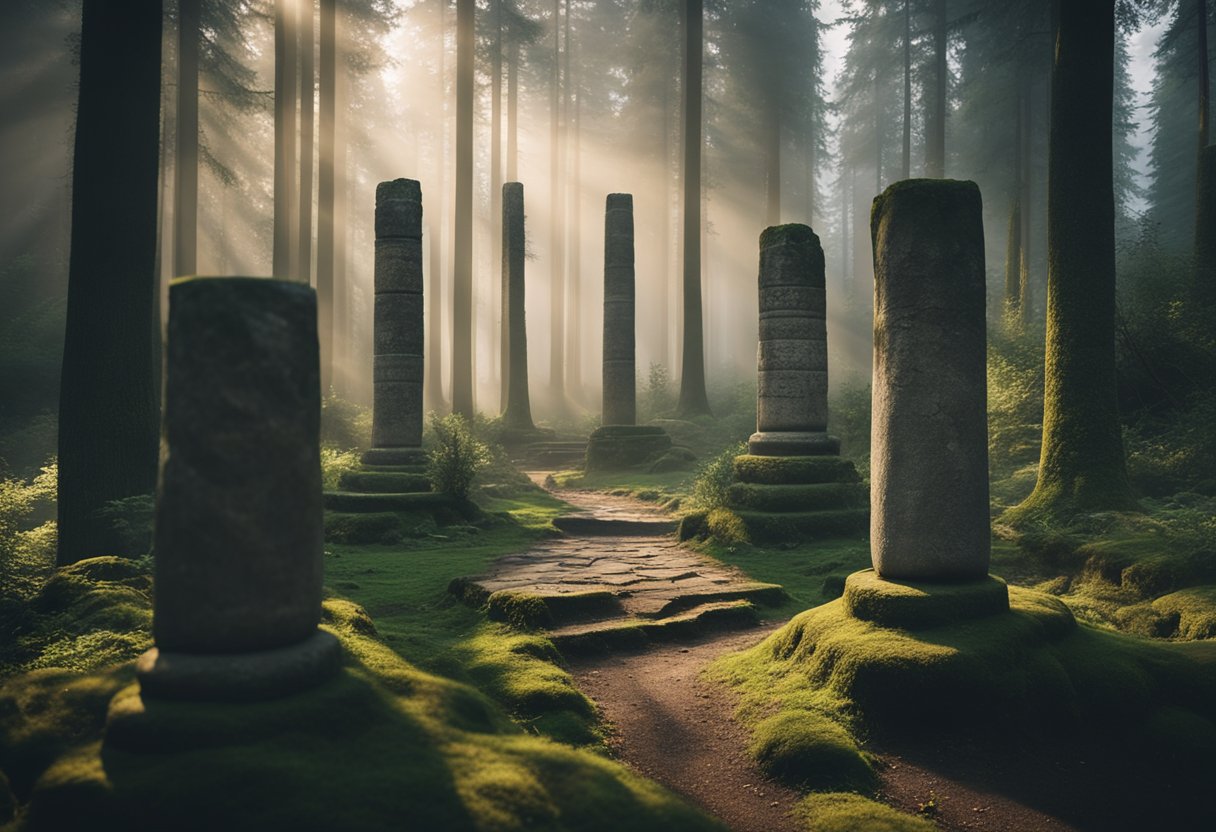
Updated On: March 16, 2024 by Maha Yassin
In the annals of history, the wisdom of the ancient Druids and the sages of the East has always been a subject of fascination and intrigue. On the verdant lands of Europe, the Druids of the Celtic world emerge as figures enshrouded in mystique, revered for their profound connection to nature and the spiritual realm. Their practices, deeply rooted in the earth and its cycles, reveal a unique understanding of the material and the mystical. They stand as a testament to the religious life of the ancient Celts and a far-reaching influence that echoes through time.
Comparable in their pursuit of knowledge and spiritual depth, the sages of the Eastern traditions have also left an indelible mark on the fabric of history. These venerable individuals were widely acclaimed for their philosophical insights and contributions to the moral and metaphysical discourse. From the intricate philosophies of the Far East to the rich tapestries of Middle Eastern thought, the sages of the East provided a foundation for a myriad of spiritual and cultural practices that continue to enrich human understanding.
Historical Context of The Druids and The Sages
Before delving into the specifics, we must understand the Druids as the high-ranking professional class in Celtic culture. Not only were they religious leaders but also legal authorities, adjudicators, lorekeepers, medical professionals, and political advisors.
Druidism in Ancient Times
Druids held central roles within ancient Celtic cultures, particularly in regions that would come to be known as Gaul and the British Isles. Our historical knowledge of Druidism largely depends on limited archaeological finds and second-hand accounts from classical scholars. Notably, Julius Caesar provided descriptions of Druids in his accounts of the Gallic Wars, though their accuracy is debated.
Many of the ceremonial and judicial functions of Druids took place in areas considered sacred, such as groves of oak trees. Oak groves were symbolic to them due to their longevity and might, hence, the Druids’ reputation as “knower of the oak tree”.
The Celts were not confined to a single territory but spread across many regions of Europe, with varying customs and languages. Britain, however, is often highlighted for its retention of Druidic practices, even in the face of Roman conquest.
The Influence of the Romans
The arrival of the Romans had a dual impact on the Druids and their practices. While Julius Caesar’s campaigns during the Gallic Wars sought to incorporate Gaul under Roman rule, they also suppressed the Druidic class, as their influence was contrary to Rome’s administrative and religious policies.
Post the Roman conquest, much of the indigenous traditions—including those of the Druids—were either obliterated or assimilated into the vast cultural mix of the Roman Empire. However, some elements survived by adapting to the new cultural landscape imposed by Roman governance. This resistance is most prominent in the British Isles, where Druidic practices and teachings found ways to persist, a testament to the cultural resilience of the Celts in the face of overwhelming change.
Druidic Practices and Beliefs
In our exploration of Druidism, we cast light on a path steeped in rituals and reverence for nature. The Druids of old held roles that extended well beyond religious duties, ingrained deeply in the social fabric of their culture.
Rituals and Ceremonies
Druidic Rituals often took place within circles, symbolic of the eternal cycle of life and seasons, frequently in the presence of sacred trees like the oak. These ceremonies intertwined with the natural world, reflecting a profound spirituality. Celebrations like the solstices and equinoxes were pivotal, marking the passage of time and the Earth’s rhythms. Sacrifices played a part in these rites; however, contrary to some historical accounts, human sacrifices are not part of modern Druidry and are bound by today’s legal and ethical standards.
Roles and Functions of Druids
Druids in ancient times were more than just priests; they were teachers, judges, and philosophers. As keepers of wisdom, they presided over legal disputes, educated the youth in lore and wisdom, and were considered intermediaries between the gods and the people. They believed in the power of magic and the sanctity of nature, principles still revered by those following Druidic paths today. Their beliefs formed a bedrock for a moral code based on respect for life and the natural world, a tradition that honours their legacy in contemporary practices.
Celtic Spirituality and Mythology
In our exploration of Celtic spirituality, we uncover a deep-seated reverence for the natural world and a rich tapestry of mythology populated by many deities and spirits.
Sacred Groves and Nature Worship
The ancient Celts held an intimate connection with the land, seeing the divine in the raw elements of nature. Sacred groves were not mere clusters of trees but the dwelling places of spirits and the stage for religious ceremonies. To the Celts, oak groves were particularly holy, embodying the essence of life, death, and the afterlife. Nature was a fundamental part of the Celtic soul, where mystery and the mortal world intertwined seamlessly.
The Pantheon and the Otherworld
Celtic deities presided over every aspect of existence, from the mundane to the mystical. Their pantheon was vast and varied, with gods like Lugh symbolising skills and crafts, while The Morrígan represented war and sovereignty. These figures often interacted with humans, revealing the thin veil between the mortal realm and the Otherworld. This ethereal place was where souls journeyed after death, a realm infused with magic and replete with endless possibilities, reflecting the Celts’ complex beliefs in the continuity of the spirit even after life ceases.
Our understanding of these customs is enhanced by the insights in “The Druids: Who Were the Ancient Celtic Priests?” allowing us to appreciate the centrality of nature and the sacred groves in Celtic worship. Moreover, in aligning with the earth’s rhythms, the Celts performed rituals and sacrifices, further cementing their relationship with the gods and the land.
Interactions with Other Cultures
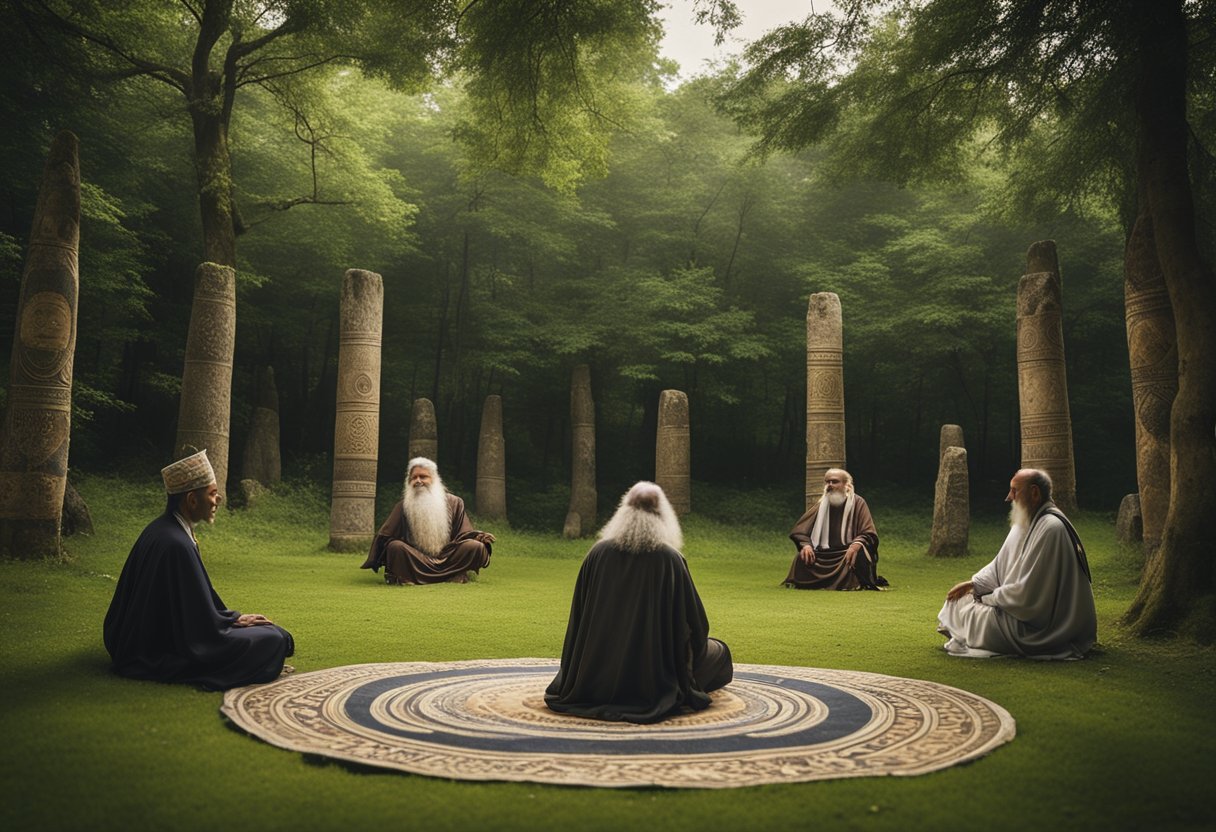
We observe that throughout history, the Druids and the sages of the East engaged in significant and transformative interactions with other cultures. These exchanges, marked by resistance and adaptation, left indelible marks on the tapestry of world knowledge and belief systems.
Druids and the Classical World
The Druids frequently came into contact with the classical world, particularly through encounters with ancient Rome. Historical writers like Pliny the Elder provide accounts of Druids, often marvelling at their complex belief systems and knowledge of natural phenomena. The Druids’ wisdom, especially their understanding of botany and their use of Latin, facilitated communications with Roman scholars and contributed to the mutual exchange of knowledge. Despite these interactions, the Druids often resisted the encroaching influence of Roman traditions, striving to maintain their own culture and practices amidst the dominion of a burgeoning empire.
Responses to the Spread of Christianity
With the spread of Christianity, the Druids faced a new wave of cultural and religious pressures. Our history shows that the interface with Christian missionaries and clerics was complex in regions like Gaul and the British Isles. On one hand, there was resistance from the Druids as the new religion threatened their traditional roles in society. On the other, adaptation occurred, and some historians suggest that Druidic practices and symbols were incorporated into local Christian traditions to ease the transition for the populace. Key areas of knowledge passed down through the Druidic oral traditions faced the risk of being lost, but some were preserved by Christian monks who documented them in written form.
Druid Symbols and Artifacts
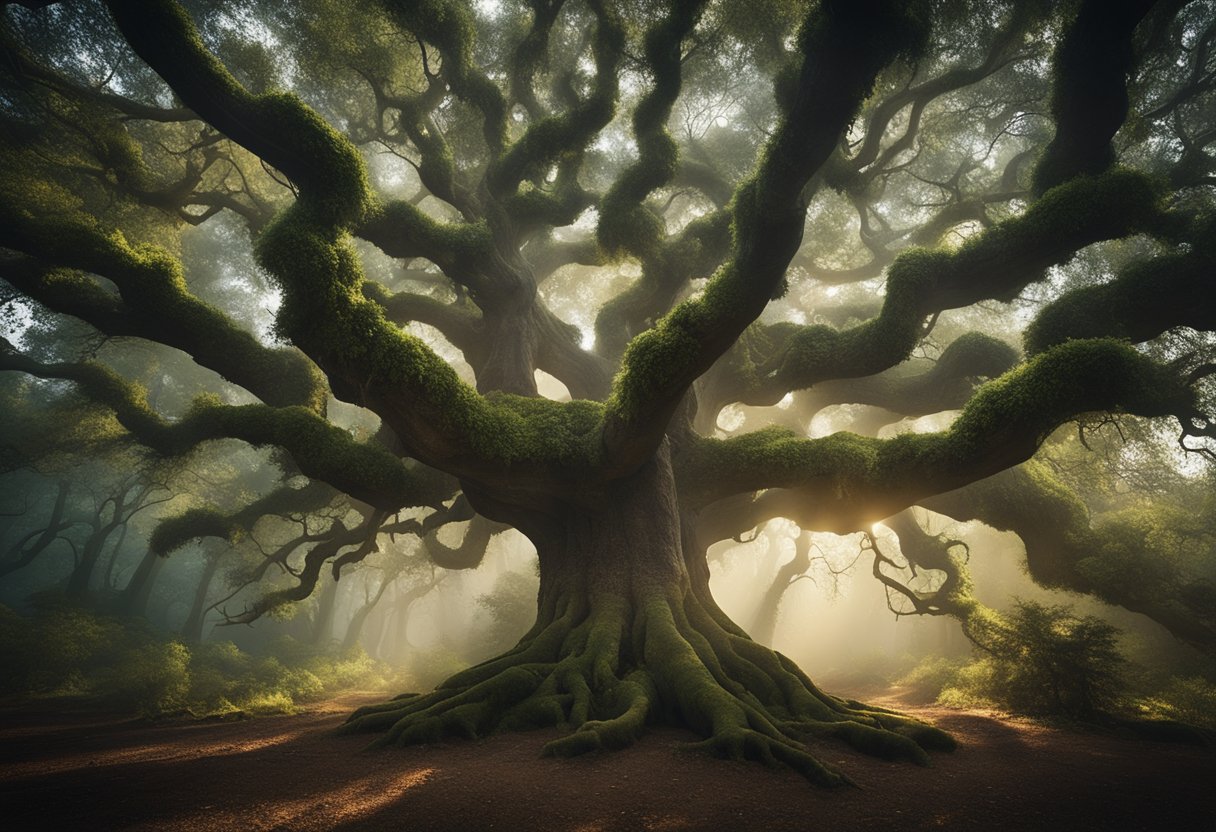
In exploring the Druids, their symbols and artefacts reveal a profound reverence for nature and the knowledge they attributed to it.
Significance of the Oak and Mistletoe
The oak tree is a central emblem in Druidic belief, symbolising strength, resilience, and wisdom. The Druids, deriving their name from deru, meaning ‘oak’, saw themselves as the knowers of the oak. They held ceremonies in oak groves, believing these trees to be sacred. Mistletoe, especially when found on oaks, was highly esteemed as a powerful plant that could heal diseases and ward off evil. It was collected ritualistically, using a golden sickle and never letting it touch the ground to preserve its purity.
The importance of oaks and mistletoe is well documented, with the acorn often venerated for its symbolism of growth and potential. This admiration for the oak and mistletoe is evident in the various artefacts and associated ceremonies, encapsulating their integral role in Druid culture.
Iconic Sites and Their Mysteries
Stonehenge is an iconic site of great importance, shrouded in mystery and speculation. The precise purpose of this prehistoric monument has been the subject of numerous studies, and contemporary belief suggests that it could have been an astronomical calendar or a place of worship and ceremony. The massive stone structures align with the solstices, further cementing Druidic intrigue with natural phenomena and celestial events.
Though not exclusively tied to the Druids, Stonehenge’s enigmatic presence has often been linked with their practices, possibly as a significant ceremonial site. Additional evidence suggests Druids may have conducted rituals there, drawn by the site’s alignment with the sun, moon, and stars, which were integral to their belief system.
Druidic Legacy and Modern Interpretations
In exploring the timeless wisdom of the Druids, we discover how modern Druidism weaves together enduring values and philosophies from ancient Celts to inform contemporary spiritual practice.
From Ancient Texts to Modern Druidism
Ancient Roots: The Druids, esteemed as the intellectual elite of Celtic societies, left a legacy grounded in a profound respect for nature, poetry, and lore. Their practices, often shrouded in mystery due to the lack of written records, have given rise to a Druid revival that seeks to apply their ancient wisdom to modern contexts.
Modern Movement: Today, we see a thriving modern Druidism that honours the Druids’ historical significance while adapting their teachings for present-day relevance. This spiritual path continues evolving, encouraging adherents to find harmony with the natural world and their communities. The principles that guide modern Druidism emphasise harmony, creativity, and a deep-seated reverence for the Earth.
Intersecting Values: The values embraced in modern Druidism resonate with many of the philosophies found in Eastern traditions. These include living in balance, cultivating wisdom, and fostering a symbiotic relationship with our surroundings.
In our reflection on ancient texts and the continued practice of Druidism, we observe a tapestry of ideas that weave the past into the tapestry of contemporary spirituality. Our connection to this lineage enriches our understanding of Celtic spirituality and contributes to the broader discourse on living a life intertwined with nature’s rhythms and cycles.
Archaeological Insights
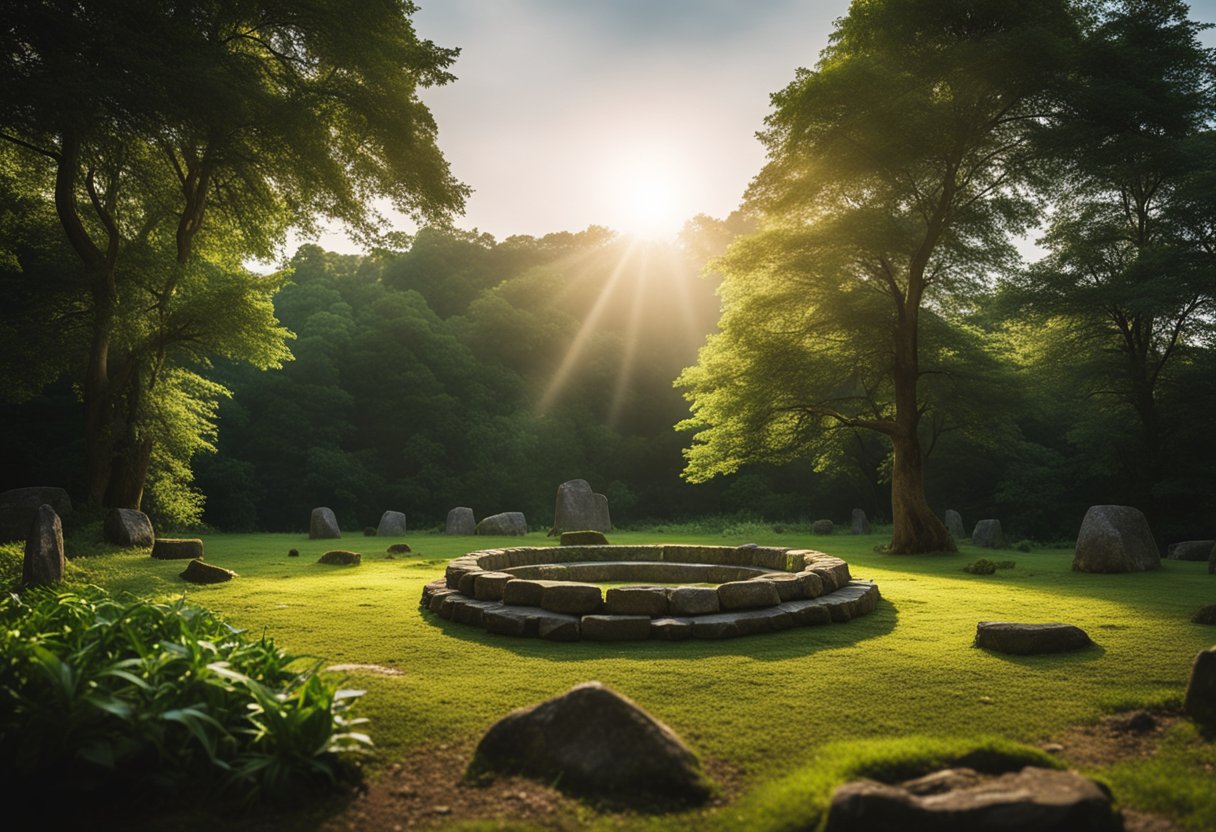
In delving into the ancient wisdom of the Druids and the sages of the East, archaeological findings play a crucial role in unearthing the practices and beliefs of these enigmatic figures from the past.
Bog Bodies and Sacrificial Remnants
Bog bodies like the famous Lindow Man offer us a visceral glimpse into the Iron Age, providing evidence of ritualistic sacrifices steeped in the mysterious customs of the Druids. The preservation of these bodies in peat bogs is extraordinary, with skin and internal organs often intact due to the unique conditions of cold, waterlogged environments lacking in oxygen. Analyses of such remains have revealed violent deaths that hint at blood rituals, possibly as offerings to deities or for communal justice.
The Archaeology of Druidic Sites
Exploring the archaeology of Druidic sites has led to the discovery of various ceremonial spaces and altars where practices such as divination, judicial proceedings, and teaching likely took place. Excavations of these sites show an intriguing connection with natural elements, particularly water, suggesting that these were sacred spaces for the Druids. The arrangement of stones, remnants of wooden structures, and artefacts like ritualistic tools all contribute to our image of where and how these ancient people practised their rites and ceremonies.
The Role of Women in Druidism
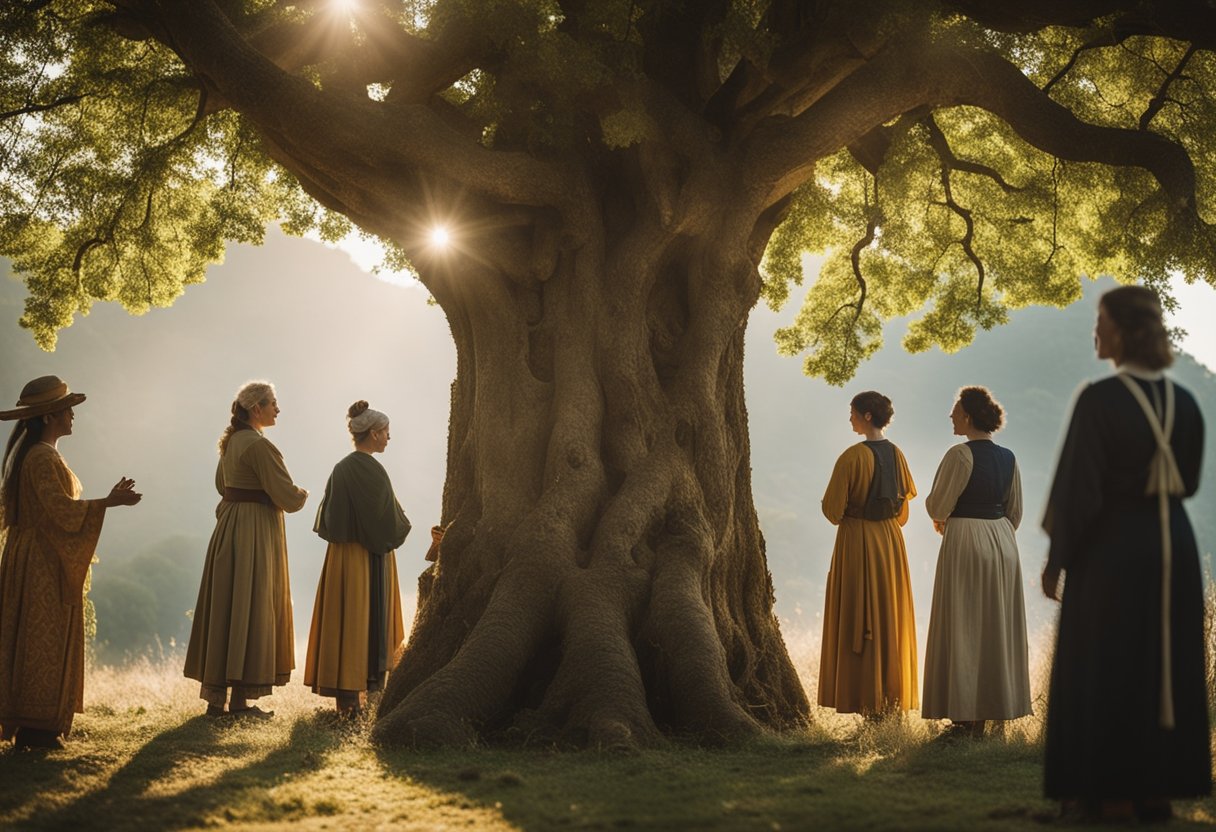
In the tapestry of Celtic history, women in Druidism hold a place of reverence and power.
Priestesses and Female Figures in Celtic Society
In ancient Gaul, women were integral to the religious and social spheres, often stepping into roles as mediators and guardians of Celtic wisdom. As priestesses, these women were entrusted with maintaining the spiritual well-being of their communities and holding sacred the mysteries of the natural world. They were not merely passive figures but actively engaged in societal matters.
Historical accounts suggest that female Druids were influential, both spiritually and politically. Their roles extended beyond ceremonial practices, including diplomatic engagements, such as negotiating treaties and resolving disputes. This challenges the frequent misconception that Druidism was a male-dominated field. Instead, women enjoyed a measure of equality, especially when compared to their contemporary Roman or Greek counterparts.
The Druidesses possessed knowledge of the Celtic word and lore, and they were often ascribed abilities akin to magic, such as prophecy and healing, which added an aura of mystery surrounding them. The power and status of these women in Celtic tribes were significantly higher than in many other ancient societies, where female voices were regularly marginalised.
It’s clear from these practices that women in ancient Druid societies were not only present but were vital to the religious and cultural identity of the Celts. Through their wisdom and influence, they helped shape and sustain the spiritual framework of their time.
Encounters with the Druids in Classical Literature
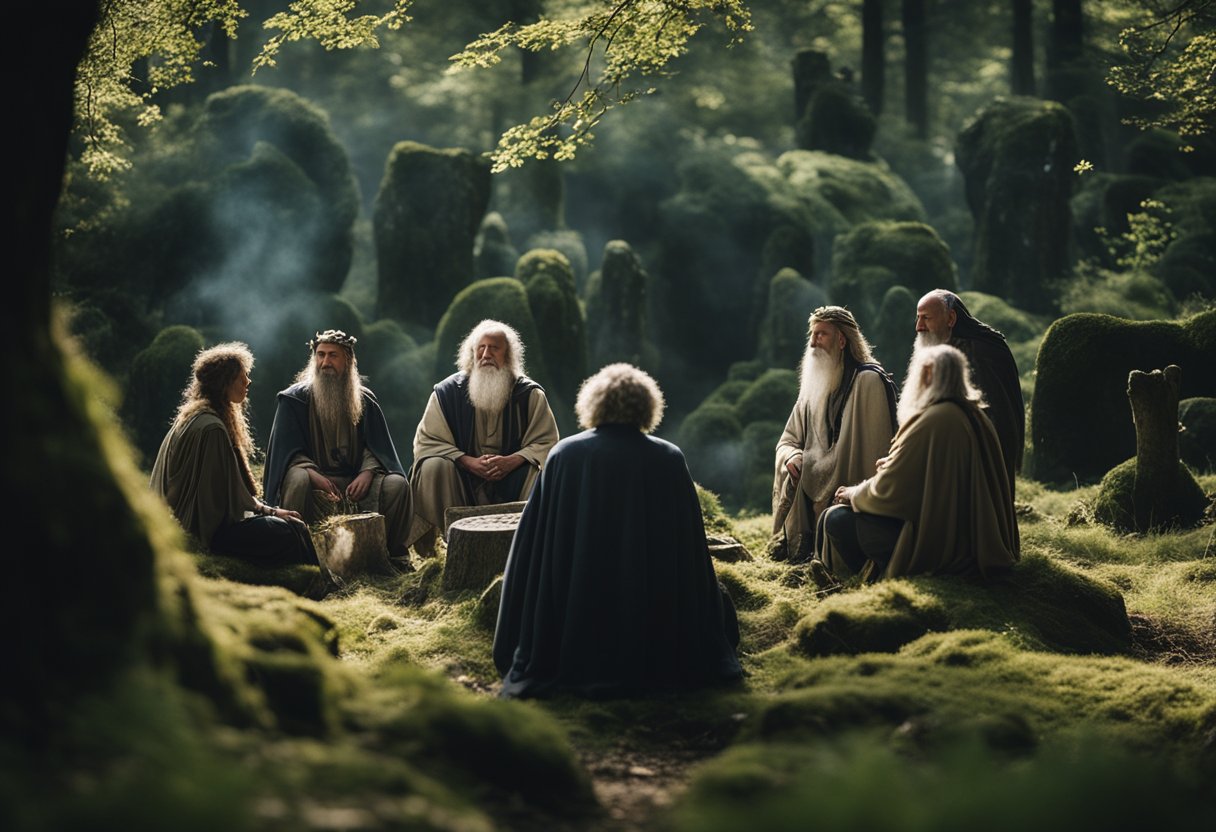
Ancient texts provide a fascinating glimpse into the beliefs and practices of the Druids, including intriguing descriptions by Roman figures such as Julius Caesar. These accounts form the bedrock of our classical understanding of the Druidic tradition.
Accounts by Julius Caesar and Others
In his work, Commentarii de Bello Gallico, Julius Caesar detailed encounters with the Druids, whom he referred to using the Latin term Druids. He depicted them as an influential class within Celtic society, involved in various activities from education and legal matters to religious rituals. Caesar’s accounts highlight the Druids’ belief in the soul’s immortality, which they thought transmigrated after death.
Contemporary historians also draw on descriptions from other classical writers who mentioned the Druids. Their Latin texts used terms such as fili, meaning sons or descendants, which may indicate the inheritable position within the Druidic order.
While much of the ancient literature does not delve deeply into the specifics of the Druidic rituals, it consistently attributes a significant societal role to the Druids. It illustrates their deep influence on their communities. These literary remnants from Caesar and various other Latin authors constitute a key source of information, providing us with snippets of insight into the spiritual and judicial authority the Druids wielded over ancient Celtic societies.
Controversial Topics in Druidic Studies

In examining Druidic studies, one must tread carefully through the minefield of controversial topics, particularly when discussing the extent and nature of Human Sacrifice and War.
The Realities of Human Sacrifice and War
It is well documented that in ancient religion and spirituality, Druids held significant influence amongst Celtic societies. They are often shrouded in a veil of mystery due to scant and speculative historical sources. One such contentious subject is the actuality of human sacrifice within Druidic practices. Many ancient writers, such as Julius Caesar, offered narratives suggesting that Druids performed human sacrifices as part of their religious rituals. However, this perspective is under intense scrutiny, with some historians considering it a form of propaganda to justify the Roman conquest of Celtic lands.
On the other hand, violence and warfare were undeniable elements of Celtic society, and Druids, as key figures, may have played roles in conflicts, be it inciting rebellion or acting as intermediaries. Claims of Druidic involvement in acts of violence, such as murder or the use of poisons, often come from the same classical sources that are accused of being biased.
The treatment of captives in war further inflames the debate. Some suggest that captives might have been sacrificed, but again, the lack of conclusive evidence leaves this assertion open to speculation. The archaeological record offers little clarity, leaving researchers piecing together fragmented accounts and material culture to construct a narrative.
Our collective understanding of the Druids and their customs continually evolves as new evidence comes to light. While the fascination with their supposed dark practices captures the imagination, we must approach these topics with a balanced perspective, acknowledging the complexities and limitations of our sources.
Druidic Wisdom and Cultural Influence
As we explore the profound impact of the Druids, we find their wisdom profoundly influencing philosophy and science, leaving a lasting legacy in various forms of cultural expression.
Contributions to Philosophy and Science
Druids were respected as learned teachers and philosophers, and they were thought to possess extensive knowledge of astronomy and natural science. Their instruction methods were said to be rigorous, often spanning many years, and were aimed at understanding the natural world and the cosmos. Poetry and prophecy were two arts in which they excelled, with their teachings often delivered in verse to aid in memorisation and transmission.
These ancient sages promoted peace, serving as mediators and conflict resolution experts within their communities, and were known for their profound insights into the human condition. Such contributions positioned them not only as spiritual guides but also as intellectual leaders of their time.
Legacy in Art, Literature, and Philosophy
The Druids’ influence extended beyond their teachings; it permeated the arts, with bards and poets drawing inspiration from Druidic wisdom. Their legacy endures in literature, where echoes of their philosophies can be found in the works of later poets and thinkers.
Their mystical practices, often associated with magic, have captured the imagination of artists throughout the centuries, adding a rich, enigmatic layer to the cultural fabric of societies influenced by their lore. This mystery enhances their portrayal in visual arts, where Druidic themes contribute to a diverse cultural heritage that still resonates with us today.
In contemplating the persistent allure of Druidic culture, our appreciation for their wisdom and its intrinsic value to our shared heritage grows ever stronger, as does the recognition of their place in the annals of human achievement.
Frequently Asked Questions
This section addresses some of the most common queries about the Druids and their ancient wisdom. We’ll shed light on the significance of trees, the interweaving of mythology with their practices, their history, the causes of their downfall, the distinctiveness of their practices compared to other pagan rituals, and the core beliefs upheld by the Ancient Order of Druids.
What is the significance of trees within Druidic beliefs?
Trees are central in Druid beliefs, often revered as sacred entities. The oak, in particular, is associated with strength and wisdom, seen as a portal to the otherworld and a symbol of the Druids’ profound connection with nature.
How does Druid mythology intertwine with their practices and culture?
Druid mythology is deeply embedded in their cultural practices, serving as a framework for seasonal rituals and providing allegorical insights into the human condition. Stories of deities and nature spirits reflect an understanding of the natural world and its cycles.
Can you outline a brief history of the Druids from ancient times to their decline?
Druids were the learned class among the ancient Celts, acting as priests, teachers, and judges. They held great influence until the Roman conquests, after which Christianity gradually overshadowed Druidism, leading to its decline.
Who were the primary adversaries responsible for the downfall of the Druidic orders?
The primary adversaries of the Druids were the Romans, who saw the Druids as a unifying force of the Celtic people and a threat to Roman rule. Later, the spread of Christianity played a significant role in the further dissipation of Druidic practices.
In what ways do Druidic practices differ from general pagan rituals?
Druidic practices are distinct from broader pagan rituals in their deep reverence for nature, particularly trees, and in their intellectual tradition, which includes poetry, legal matters, and mediation, diverging from the more widely varied practices of other pagan paths.
What are the core beliefs and tenets of the Ancient Order of Druids?
The Ancient Order of Druids embraces a spiritual path rooted in reverence for nature, the celebration of the arts, and the pursuit of wisdom. They hold no pretence of being ancient Druids but continue a rich tradition of nature, spirituality and cultural heritage.






